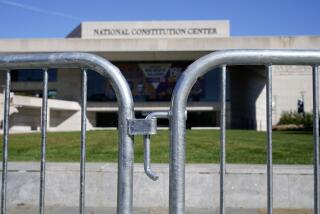President’s Response to ‘Cheating’ Is Out of Proportion
- Share via
In his recent statement on interim restraint, President Reagan said that the United States was no longer bound by the framework of the SALT treaties that the Soviet Union had repeatedly violated. Nonetheless, Reagan expressed willingness to adhere technically to the SALT limits if the Soviets were to alter their wayward behavior.
No one, including Reagan, expects the Soviets to admit “cheating” on their SALT obligations or to adopt a philanthropic posture in Geneva. Indeed, the hope among some officials in Washington is that the Soviets will now act even more intransigently, thereby enabling the Administration to deregulate arms control, proceed with unrestrained military competition and achieve ultimate U.S. superiority.
With its incessant rhetoric of Soviet non-compliance, the Administration has sought to manipulate public attitudes about arms control and superpower accommodation. Administration officials have singled out three Soviet actions--the construction of the Krasnoyarsk radar, the deployment of the SS-25 missile and the encryption of telemetry--that they contend violate the SALT-ABM treaties. Most arms-control experts, however, challenge the President’s conclusions, and many consider them spurious.
According to the Administration, the Krasnoyarsk radar’s siting in the interior of the Soviet Union and its inward orientation toward Siberia violate Article VI of the ABM treaty that constrains the location of early-warning radars. The Soviets insist that the radar’s mission is to track satellites. Since the Krasnoyarsk radar looks like other Soviet early-warning radars, the U.S. position is not unreasonable. But, as long as the Krasnoyarsk facility is not functioning as an early-warning radar, the Soviets have not technically violated the treaty. Moreover, radars used for space-tracking or intelligence-gathering are exempted from the ABM treaty.
In the case of the SS-25, SALT II permits the development and deployment of one “new type” of light strategic ballistic missile. According to the Reagan Administration, the SS-25 is a second, and therefore illegal, new type. The Soviets maintain that the SS-25 is a legally permissible modification of the SS-13, a missile deployed in the late 1960s that performed poorly.
U.S. officials argue that the SS-25 violates SALT II because it exceeds by more than 5% the throwweight of the SS-13 and because of the discrepancy in the ratio of the weight of the missile’s warhead to its total throwweight. But the U.S. intelligence community has acknowledged that data on the performance of the SS-13 are spotty, which makes it difficult to form a conclusive judgment about the difference in throwweight between the two systems. And the Soviets have attributed the apparent discrepancy between the weight of the warhead and the missile’s throwweight to the instrumentation package that they included during flight testing.
A similar ambiguity pertains to the encryption of telemetry. The Soviets contended in SALT II that test data were not essential for the United States to verify limits of new ICBMs. Nor was the United States willing to reveal fully all its missile flight data. The result was a broadly worded compromise that permits some encryption short of deliberate denial of information. The Soviets may have deliberately concealed test data, but the Reagan Administration has refused the Soviet request to specify what information has been denied on the ground that U.S. intelligence-gathering techniques might be compromised.
In each of these cases it could be said that the Soviets have exploited loopholes in SALT II and the ABM treaty that violate the spirit of the agreement. It is questionable, however, whether the Soviets have technically violated these treaties. Militarily, Soviet actions have not jeopardized U.S. security. The Krasnoyarsk radar is not significant. The deployment of the SS-25, a single-warhead mobile missile, actually contributes to strategic stability because it is more likely to survive a first strike. The encryption of telemetry makes the job of verification harder, but it has not impeded it. Indeed, the Administration provides regular public updates on the latest number of Soviet SS-20 and SS-25 deployments.
Technically, America will remain in compliance with the SALT framework until the 131st cruise-missile-carrying B-52 is deployed later this year. Exceeding the numerical limits of SALT II is not likely to result either in last-minute Soviet concessions or in U.S. strategic superiority. What it will do is remove the barriers to mutual arms restraint and hasten the collapse of two decades of arms control.
Rather than jettison arms control altogether, clearly a disproportionate response, the President might consider implementing his policy of proportionate response. To meet the challenge of Krasnoyarsk, the United States could deploy penetration aids on ballistic missiles or increase the number of warheads on missiles. The Administration could also inform the Soviets that it plans to deploy the Midgetman missile, a second new type, in response to SS-25 deployments.
A policy of proportionate response should not be pursued either to appease the Soviets, as the extreme right may suspect, or to nurture the belief that arms control is a panacea for resolving the U.S.-Soviet conflict, as some on the left still fantasize. Such a moderate course should be followed because it is in U.S. security interests to do so.
More to Read
Sign up for Essential California
The most important California stories and recommendations in your inbox every morning.
You may occasionally receive promotional content from the Los Angeles Times.










